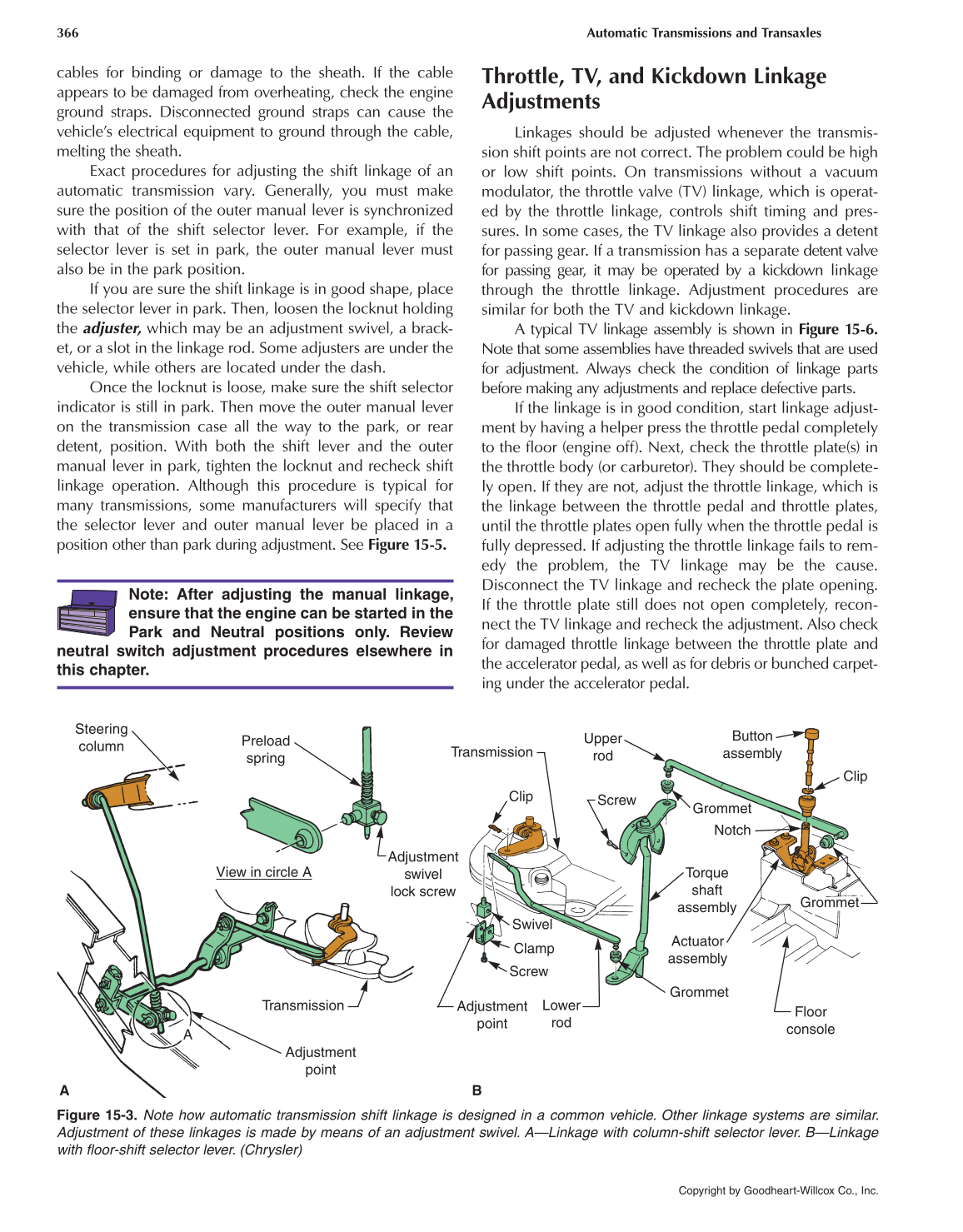Copyright by Goodheart-Willcox Co., Inc.
366 Automatic Transmissions and Transaxles
Steering
column
View in circle A
Preload
spring
Adjustment
swivel
lock screw
Clip
Transmission
Screw
Upper
rod
Grommet
Grommet
Grommet
Notch
Button
assembly
Clip
Torque
shaft
assembly
Actuator
assembly
Floor
console
Lower
rod
Swivel
Clamp
Screw
Adjustment
point
Adjustment
point
Transmission
A
A B
Figure 15-3. Note how automatic transmission shift linkage is designed in a common vehicle. Other linkage systems are similar.
Adjustment of these linkages is made by means of an adjustment swivel. A—Linkage with column-shift selector lever. B—Linkage
with floor-shift selector lever. (Chrysler)
Note: After adjusting the manual linkage,
ensure that the engine can be started in the
Park and Neutral positions only. Review
neutral switch adjustment procedures elsewhere in
this chapter.
cables for binding or damage to the sheath. If the cable
appears to be damaged from overheating, check the engine
ground straps. Disconnected ground straps can cause the
vehicle’s electrical equipment to ground through the cable,
melting the sheath.
Exact procedures for adjusting the shift linkage of an
automatic transmission vary. Generally, you must make
sure the position of the outer manual lever is synchronized
with that of the shift selector lever. For example, if the
selector lever is set in park, the outer manual lever must
also be in the park position.
If you are sure the shift linkage is in good shape, place
the selector lever in park. Then, loosen the locknut holding
the adjuster, which may be an adjustment swivel, a brack-
et, or a slot in the linkage rod. Some adjusters are under the
vehicle, while others are located under the dash.
Once the locknut is loose, make sure the shift selector
indicator is still in park. Then move the outer manual lever
on the transmission case all the way to the park, or rear
detent, position. With both the shift lever and the outer
manual lever in park, tighten the locknut and recheck shift
linkage operation. Although this procedure is typical for
many transmissions, some manufacturers will specify that
the selector lever and outer manual lever be placed in a
position other than park during adjustment. See Figure 15-5.
Throttle, TV, and Kickdown Linkage
Adjustments
Linkages should be adjusted whenever the transmis-
sion shift points are not correct. The problem could be high
or low shift points. On transmissions without a vacuum
modulator, the throttle valve (TV) linkage, which is operat-
ed by the throttle linkage, controls shift timing and pres-
sures. In some cases, the TV linkage also provides a detent
for passing gear. If a transmission has a separate detent valve
for passing gear, it may be operated by a kickdown linkage
through the throttle linkage. Adjustment procedures are
similar for both the TV and kickdown linkage.
A typical TV linkage assembly is shown in Figure 15-6.
Note that some assemblies have threaded swivels that are used
for adjustment. Always check the condition of linkage parts
before making any adjustments and replace defective parts.
If the linkage is in good condition, start linkage adjust-
ment by having a helper press the throttle pedal completely
to the floor (engine off). Next, check the throttle plate(s) in
the throttle body (or carburetor). They should be complete-
ly open. If they are not, adjust the throttle linkage, which is
the linkage between the throttle pedal and throttle plates,
until the throttle plates open fully when the throttle pedal is
fully depressed. If adjusting the throttle linkage fails to rem-
edy the problem, the TV linkage may be the cause.
Disconnect the TV linkage and recheck the plate opening.
If the throttle plate still does not open completely, recon-
nect the TV linkage and recheck the adjustment. Also check
for damaged throttle linkage between the throttle plate and
the accelerator pedal, as well as for debris or bunched carpet-
ing under the accelerator pedal.
